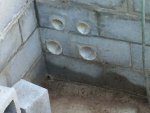With a couple of days’ rain predicted, but a dry morning, I decided that I would move my efforts in-doors. This means working on the electricals, which will be in the garage, out of the weather.
The first part of this effort is to drill a hole for a conduit through the 18’ of clay that separates the pit and the garage. Drilling rather than trenching because there are many plants in the path, which I don’t want to disturb.
I have a tool called a Borzit for such jobs. I bought it to run a conduit under my driveway when I didn’t want to trench through the asphalt. It’s a clever device. It requires your own ½” heavy-duty drill motor, and your water hose connected to a spigot. The device is inserted into your drill and connected to the hose. The other end of the Borzit threads onto a piece of ¾” black-iron pipe, such as one uses for natural gas lines, and the far end of that pipe screws onto the drill bit, which is a crude sort of affair for boring through dirt.
In use, one turns on the water, starts the drill, and points it in the direction you want to go with the hole. Of course, if you are boring horizontally, you have to dig an access hole to stand in, and where the water will collect and soak your shoes, pants, etc.. The water runs through the drill pipe (the ¾” pipe) and spurts out of the drill bit to lubricate the effort. The used water comes back out the hole that you have drilled.
In effect, this drill compacts the earth surrounding the hole that it’s making, leaving a place to insert a conduit, if you’ve sized the conduit and drill bit correctly. Small stones get pushed out of the way. As the hole gets longer, you thread on additional sections of pipe. People report being able to drill 75’ or more with this arrangement. They must be stronger than I!
For the current effort, I wanted a 2” hole to accept a 1 ¼” conduit, as there are many wires to run through it. It turns out that a 2” bit requires a goodly amount of force to punch through what turned out to be a rock pile from constructing the garage! But eventually I got it forced through: the first of two, one for 24volt lines, and the other for 110volt lines, as required by code.
Of course, getting the conduit through the hole was not so easy. Apparently, some of the rocks would jump back into the “hole” as soon as the drill was pulled out. There followed a number of tries of re-drilling in the same hole, pulling out and disassembling the lengths of pipe, re-trying to push the conduit through, etc. Eventually, SUCCESS.
Drilling the second hole was also not so easy. I can verify that the drill bit will NOT go through old tree stumps that happen to be in your desired path. Digging, chainsaw, demolition saws, etc., followed, eventually getting the obstruction reduced enough that I could run the conduit in two sections, joining it around the stump. Ain’t nothin’ simple in these jobs.
Oh, did I mention that half way through this effort it started to drizzle? By the time I finished I was head-to-foot wet clay mud. Ugh. I’ve done many dirty jobs here; this was the worst.
Here's the conduit going through the garage wall:


